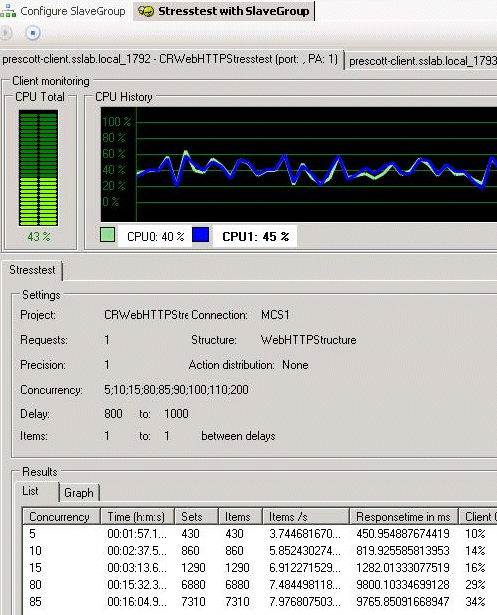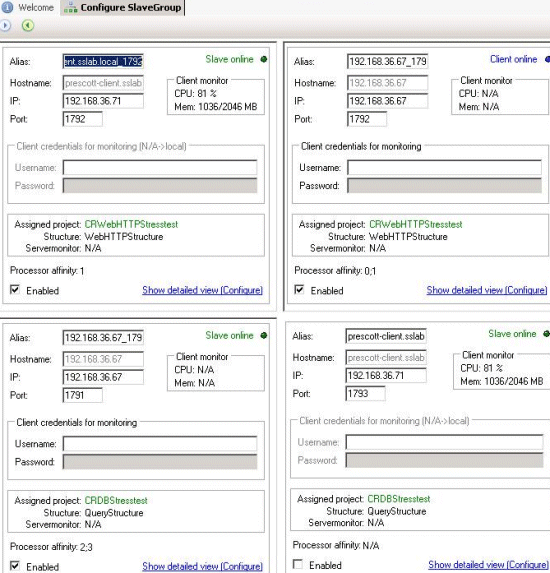Real-world virtualization benchmarking: the best server CPUs compared
by Johan De Gelas on May 21, 2009 3:00 AM EST- Posted in
- IT Computing
vApus: Virtual Stress Testing
Testing uses real-world databases and websites. To make this as realistic as possible we use vApus. vApus or Virtual Application Unique Stresstest is a stress test developed by Dieter Vandroemme, lead developer of the Sizing Server Lab at the University College of West-Flanders. The basic setup works as follows. Each application is logged during business use in the peak hours. These logs are analyzed by the vApus application and queries/URLs requested are grouped into user actions. vApus will simulate the actual actions that people have done by performing these actions again on the application running on a server in our lab. A well-tuned threading mechanism developed in-house launches one thread per user.
The cool thing is that vApus allows us to perform several completely different stress tests on several servers simultaneously. This is ideal for virtual server testing. Let's discuss this a bit more.

Above you can see the connection to -- in this case -- the Sun XFire 4450 server (which is no longer in our lab). Several performance monitors can be started on each tested server. The CRWebHTTPBenchmark is the first benchmark that will be performed, in our case on virtual servers 2 and 3. The CR means "Continuous Rate": each user will perform an action every second (this is configurable of course). The CRDBBenchmark (the third item under the "SunxFire" connection) is the Continuous Rate benchmark for the Decision Support Database.

Above you see what the results look like, in this case on one of our slowest servers. Concurrency indicates how many users are hitting the website, and Item/s is the throughput. We constantly monitor the client CPU to make sure that the client machine is never the bottleneck.
The vApus "master" process launches several separate processes called "slaves", which will stress test a separate server or VM. In our case, there are three slaves: two web tests and one database test will all run in parallel. As vApus must be cheap to use, we wanted to avoid situations where you need a massive battery of clients. Besides the fact that every Slave has an extremely tuned threading system to simulate users, each Slave can have affinity set to one or more CPU(s) of the client PC it runs on. For this test, we used two client machines: a quad-core Core 2 Quad Q6600 at 2.4GHz and our old dual Opteron 2.6GHz test system.

As you can see above, we carefully monitor CPU usage so that we are sure that our clients are never the bottleneck. The beauty of this system is that we were able to simulate between…
- 600-800 Database users on VM1
- Two times 80-110 web users on VM2 and VM3
…while running only two clients. Our quad-core client should have been sufficient, but we wanted to play it safe and give each slave at least two CPUs. The two clients and one master are directly connected via a gigabit switch to the test servers.










66 Comments
View All Comments
GotDiesel - Thursday, May 21, 2009 - link
"Yes, this article is long overdue, but the Sizing Server Lab proudly presents the AnandTech readers with our newest virtualization benchmark, vApus Mark I, which uses real-world applications in a Windows Server Consolidation scenario."spoken with a mouth full of microsoft cock
where are the Linux reviews ?
not all of us VM with windows you know..
JohanAnandtech - Thursday, May 21, 2009 - link
A minimum form of politeness would be appreciated, but I am going to assume your were just dissapointed.The problem is that right now the calling circle benchmark runs half as fast on Linux as it does on Windows. What is causing Oracle to run slower on Linux than on Windows is a mystery even to some of the experienced DBA we have spoken. We either have to replace that benchmark with an alternative (probably Sysbench) or find out what exactly happened.
When you construct a virtualized benchmark it is not enough just to throw in a few benchmarks and VMs, you really have to understand the benchmark thoroughly. There are enough halfbaken benchmarks already on the internet that look like a Swiss cheese because there are so many holes in the methodology.
JarredWalton - Thursday, May 21, 2009 - link
Page 4: vApus Mark I: the choices we made"vApus mark I uses only Windows Guest OS VMs, but we are also preparing a mixed Linux and Windows scenario."
Building tests, verifying tests, running them on all the servers takes a lot of time. That's why the 2-tile and 3-tile results are not yet ready. I suppose Linux will have to wait for Mark II (or Mark I.1).
mino - Thursday, May 21, 2009 - link
What you did so far is great. No more words needed.What I would like to see is vApus Mark I "small" where you make the tiles smaller, about 1/3 to 1/4 of your current tiles.
Tile structure shall remain simmilar for simplicity, they will just be smaller.
When you manage to have 2 different tile sizes, you shall be able to consider 1 big + 1 small tile as one "condensed" tile for general score.
Having 2 reference points will allow for evaluating "VM size scaling" situations.
JohanAnandtech - Sunday, May 24, 2009 - link
Can you elaborate a bit? What do you menan by "1/3 of my current tile?" . A tile = 4 VMs. are you talking about small mem footprint or number of VCPUs?Are you saying we should test with a Tile with small VMs and then test afterwards with the large ones? How do you see such "VM scaling" evaluation?
mino - Monday, May 25, 2009 - link
Thanks for response.1/3 I mean smaller VM's. Mostly from the load POW. Probably 1/3 load would go for 1/2 memory footprint.
The point being that currently the is only a single datapont with a specific load-size per tile/per VM.
By "VM scaling" I would like to see what effect woul smaller loads have on overal performance.
I suggest 1/3 or 1/4 the load to get a measurable difference while remaining within reasonable memory/VM scale.
In the end, if you get simmilar overal performance from 1/4 tiles, it may not make sense to include this in future.
Even then the information that your benchmark results can be safely extrapolated to smaller loads would be of a great value by itself.
mino - Monday, May 25, 2009 - link
Eh, that last text of mime looks like a nice gibberish...Clarification nneded:
To be able to run more tiles/box smaller memory footprint is a must.
With smaller mem footprint, smaller DB's are a must.
The end results may not be directly comparable but shall be able to give some reference point, corectly interpreted
Please let me know if this makes sense to you.
There are multiple dimensions to this. I may be easily on the imaginery branch :)
ibb27 - Thursday, May 21, 2009 - link
Can we have a chance to see benchmarks for Sun Virtualbox which is Opensource?winterspan - Tuesday, May 26, 2009 - link
This test is misleading because you are not using the latest version of VMware that supports Intel's EPT. Since AMD's version of this is supported in the older version, the test is not at all a fair representation of their respective performance.Zstream - Thursday, May 21, 2009 - link
Can someone please perform a Win2008 RC2 Terminal Server benchmark? I have been looking everywhere and no one can provide that.If I can take this benchmark and tell my boss this is how the servers will perform in a TS environment please let me know.